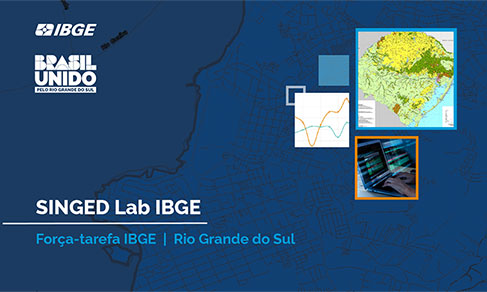Munic and Estadic 2019
Municipal and state governments offer now more services through the Internet
December 02, 2020 10h00 AM | Last Updated: December 07, 2020 01h07 PM
Highlights
- All the Federation Units had a website and so did 97.7% of the municipalities.
- Only one in four municipalities (25.4%) with a website had a apps for cell phones. Among the states, 19 had adaptable pages.
- Survey shows, for the first time, city halls and state governments that use social media for advertising initiatives, services and campaigns.
- 45% of the municipalities had specific laws that guaranteed access to information.
- All states and most municipalities had an internal control structure, which was mainly headed by permanent staff.

Municipalities, states and the Federal District expanded the services offered to citizens over the internet in 2019, as a result of the greater online presence of governments. Last year, city halls were close to universal access: 97.7% of municipalities (or 5,442) had a website, compared to 88.7% (4,943) in 2014, while all Federation Units (FUs) had web pages on the Internet since at least 2014. The data are from the Survey of Basic Municipal Information (Munic) and theSurvey of Basic State Information (Estadic), released today (2) by the IBGE.
Among the Federation Units, for example, bidding data was made available on the internet by 22 FUs (81.5%) in 2014, rising to 25 FUs (92.6%) in 2019, with the exception of Alagoas and Bahia. Access to documents (25 FUs) and to the Official Gazette, to state legislation and public finances (26 FUs) also advanced. Twenty-one Federation Units issued a tax payment slip over the internet.
On the other hand, just over half (15) of the Federation Units offered the enrollment service in public schools. And only Rondônia, Paraíba and Espírito Santo provided online scheduling for medical appointments in the public health system. In 2014, only Rondônia offered this service.
In the municipalities, information on bidding was a service made available on 61.3% of the pages of city halls in 2014, increasing to 90.9% in 2019. Access to documents (69.3%), to the Official Gazette, to the state legislation and public finances (79.8%) also increased in the period. However, only 39.1% of city halls issued tax slips over the internet. Enrollment in the public education system (3.7%) and scheduling online medical appointments (3.3%) were also offered by few municipalities in 2019.
“In five years, there has been an increase in the supply of services over the internet by the majority of city halls and state governments. But there are some services that are still offered by a few states and municipalities”, comments the survey manager, Vânia Pacheco.
Although all Federation Units offer services through their web pages, in only 19 of them was the site adapted or had it a mobile version for cell phones and tablets. In only 25.4% of the municipalities, the pages had this characteristic. In just over half of the FUs (51.9%) and in 10.8% of the cities was it possible to issue tax slips or other payment slips by cell phone.
Governments use social media to advertise actions, services and campaigns
The surveys also investigated, for the first time, the use of social media by governments. All Federation Units had profiles on these online platforms. The most frequent ones were Facebook and Instagram, both used by 26 FUs, YouTube (22 FUs) and Twitter (21 FUs).
In the municipalities, 84.0% of city halls (4,678) had profiles on social media, with Facebook (98.2%) being the most popular. Then came Instagram (46.0%), YouTube (21.8%) and WhatsApp (16.7%).
“The main activities of the states and municipalities on social media were the posting of news about the government and the dissemination of services and campaigns. Only seven FUs and 18% of the municipalities held public consultations or surveys through these platforms”, says Vânia Pacheco.
Less than half of the municipalities have a specific access to information law
In 2019, less than half of the municipalities (45.0%) had specific legislation to guarantee access to information under Federal Law 12.527, known as the Access to Information Law (LAI). This percentage, however, advanced in relation to 2014, when only 19.3% (1,075) of the municipalities reported having a law on the subject. All Federation Units had specific state legislation to guarantee access to information. In 2014, there was a specific law in only 77.8% (21 FUs) of them.
The Federation Units also claimed to provide physical or virtual means to access public information in proportions higher than those observed in 2014. The Citizen Information Service (SIC) was mentioned by 96.3% (26 FUs) in 2019, compared to 40, 7% (11 FUs) in 2014.
With or without specific municipal legislation on the subject, the majority of city halls also declared to provide physical or virtual means to access information. SIC was cited by 45.7% (2,544) of municipalities in 2019, against 24.1% (1,343) of them in 2014. Internet and telephone services also grew in 2019 compared to 2014: 86.4% against 68.4% in the first case, and 52.8% against 49.5%, in the second.
Most internal control structures were headed by permanent employees
Estadic and Munic also show that all Federation Units had an internal control structure, with an exclusive secretariat being the most recurrent one (22 FUs). In the municipalities, 94.4% (5,259) had a control area. The sector was subordinated to the head of the executive (59.0%), had an exclusive municipal secretariat (22.7%) or was linked to another secretariat (16.7%).
“All Federation Units and 91.1% (4,792) of the municipalities had personnel dedicated to internal control in structures that are called Comptroller General. The person responsible for the area, in most governments, held permanent positions, which indicates the institutionalization of this public policy”, adds the survey manager.
Among the main functions of the control areas in the Federation Units, all included controllership and government auditing. A smaller proportion acted in promoting integrity/prevention and fighting corruption, as declared by 85.2% (23) of them; ombudsman, by 77.8% (21); and internal affairs, by 74.1% (20). Internal affairs was less recurrent in the North.
In the municipalities, the activities performed were also diversified, with greater proportions for controlling expenses (95.9%) and revenues (92.1%). Activities to prevent and combat corruption (61.8%) and the application of public resources by entities under private law (53.8%) were the least recurrent. Another 3.1% (164) of the municipalities with a control structure stated that they did not apply any of the actions investigated by the survey.




















